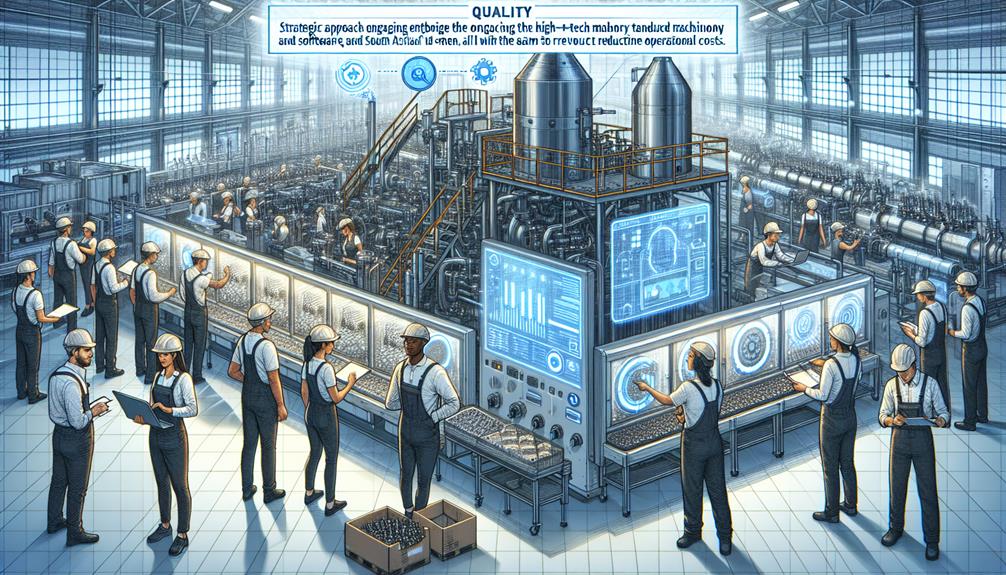Running a successful business is like sailing a ship: you must navigate through rough waters, adapt to changing winds, and find ways to reach your destination efficiently. In the ever-evolving landscape of operations, finding effective strategies for cost reduction is crucial to stay afloat and outpace the competition. With 14 proven methods at your disposal, you can steer your organization towards smoother operations, enhanced profitability, and long-term success. So, ready to set sail and uncover the secrets of reducing operational costs? Get ready to chart a course towards financial success.
Process Streamlining

Are you looking for ways to streamline your processes and reduce operational costs? One effective strategy to achieve this is through process streamlining. By examining your current processes and identifying areas for improvement, you can eliminate unnecessary steps, reduce duplication of efforts, and optimize workflow efficiency.
To begin the process streamlining journey, start by mapping out your existing processes. This will help you gain a clear understanding of each step, as well as identify any bottlenecks or inefficiencies. Once you have a visual representation of your processes, it becomes easier to identify areas that can be simplified or eliminated.
Next, prioritize the areas that will yield the greatest impact on cost reduction. Look for tasks that are time-consuming, prone to errors, or require excessive resources. By targeting these areas first, you can make significant improvements in productivity and efficiency.
Implementing technology solutions can also greatly aid in process streamlining. Automating repetitive tasks, implementing workflow management systems, and utilizing data analytics tools can help identify areas for improvement, minimize human error, and increase overall productivity.
Lastly, continuous monitoring and improvement is crucial to maintaining streamlined processes. Regularly evaluate the effectiveness of your streamlined processes and make adjustments as needed. By doing so, you can ensure that your operations remain optimized and your costs continue to decrease.
Inventory Optimization
To optimize your inventory and reduce operational costs, consider implementing effective inventory management strategies. Inventory optimization involves finding the right balance between holding enough stock to meet customer demand and minimizing excess inventory. One strategy is to implement just-in-time (JIT) inventory management, which involves ordering and receiving inventory only when it is needed for production or customer orders. By reducing the amount of inventory held in storage, you can free up valuable space and reduce carrying costs. Another effective strategy is to implement demand forecasting, which involves using historical data and market trends to predict future demand. By accurately forecasting demand, you can ensure that you have the right amount of inventory on hand, reducing the risk of stockouts or overstocking. Additionally, implementing a robust inventory tracking system can help you optimize your inventory levels. By closely monitoring stock levels and implementing reorder points, you can avoid stockouts and minimize the need for emergency orders. Overall, optimizing your inventory can lead to cost savings, improved customer satisfaction, and more efficient operations.
Supply Chain Efficiency

Improving supply chain efficiency can lead to significant cost savings and streamlined operations. By optimizing your supply chain, you can reduce waste, eliminate redundancies, and improve overall productivity. One effective strategy to achieve supply chain efficiency is by implementing advanced technologies such as automation and data analytics. These technologies can help you track inventory levels, monitor demand patterns, and streamline logistics, allowing you to make informed decisions and improve responsiveness.
Another strategy is to establish strong relationships with your suppliers. By collaborating closely with them, you can ensure timely deliveries, negotiate better pricing, and reduce lead times. Additionally, adopting lean principles can help you eliminate non-value-added activities and optimize processes throughout the supply chain. By eliminating waste and focusing on continuous improvement, you can increase efficiency and reduce costs.
Furthermore, implementing effective demand forecasting techniques can also contribute to supply chain efficiency. By accurately predicting customer demand, you can minimize inventory holding costs and avoid stockouts or overstock situations. This can result in improved customer satisfaction and reduced carrying costs.
Lastly, regularly evaluating and monitoring your supply chain performance is essential. By measuring key performance indicators such as on-time delivery, inventory turnover, and order accuracy, you can identify areas for improvement and implement corrective actions.
Outsourcing Opportunities
By optimizing your supply chain and improving efficiency, you can uncover valuable outsourcing opportunities that can further reduce costs and enhance operations. Outsourcing involves delegating specific tasks or functions of your business to external vendors or service providers. This strategic decision allows you to focus on your core competencies while leveraging the expertise and resources of specialized third-party providers.
One area where outsourcing can be particularly beneficial is in non-core business functions. These are activities that are necessary for your operations but do not directly contribute to your competitive advantage. By outsourcing functions such as IT support, payroll processing, or customer service, you can tap into the expertise and economies of scale of external providers. This not only reduces costs but also improves service quality and efficiency.
Additionally, outsourcing can provide access to specialized skills and technologies that may not be available in-house. For example, if you need to develop a mobile application but lack the necessary expertise, outsourcing to a software development company can be a cost-effective solution. Similarly, outsourcing manufacturing processes to countries with lower labor costs can significantly reduce production expenses.
However, it is important to carefully evaluate potential outsourcing partners to ensure they meet your quality standards and can effectively deliver the desired outcomes. Establishing clear communication channels, setting performance metrics, and regularly monitoring the performance of outsourced activities are essential for successful outsourcing.
Technology Integration

Consider integrating technology into your operations to streamline processes and maximize efficiency. Technology integration refers to incorporating various technological tools and systems into your operations to automate tasks, improve productivity, and reduce costs. By leveraging technology, you can eliminate manual and time-consuming processes, resulting in significant time and cost savings.
One way to integrate technology is through the implementation of a robust enterprise resource planning (ERP) system. An ERP system allows for the seamless integration and management of various business functions, such as finance, human resources, and supply chain, in one centralized platform. With an ERP system, you can automate processes, track inventory levels in real-time, and optimize resource allocation, leading to improved operational efficiency and reduced costs.
Another technology integration strategy is the use of cloud computing. By migrating your operations to the cloud, you can access and store data securely, collaborate with team members remotely, and scale your resources based on demand. Cloud computing eliminates the need for physical infrastructure, reducing costs associated with hardware maintenance and upgrades.
Additionally, consider implementing automated systems, such as robotic process automation (RPA) or artificial intelligence (AI). These technologies can handle repetitive and mundane tasks, freeing up your workforce to focus on more strategic and value-added activities. RPA and AI can analyze data, generate insights, and make informed decisions, leading to improved operational efficiency and cost reduction.
Energy Consumption Reduction
Reduce energy consumption in your operations to lower costs and increase efficiency. Implementing energy-saving measures can significantly reduce your operational expenses while also contributing to environmental sustainability. Start by conducting an energy audit to identify areas where energy is being wasted or used inefficiently. This will enable you to develop a targeted plan to reduce consumption.
One effective strategy is to upgrade your lighting system to more energy-efficient options such as LED bulbs. These bulbs use significantly less energy and have a longer lifespan, resulting in reduced energy and maintenance costs. Additionally, consider installing occupancy sensors or timers to automatically turn off lights when not in use.
Another area to focus on is heating, ventilation, and air conditioning (HVAC) systems. Regular maintenance, including cleaning filters and checking for leaks, can improve efficiency and reduce energy consumption. Adjusting temperature settings and implementing zoning systems can also help optimize energy usage based on specific areas' needs.
Investing in energy-efficient equipment, such as Energy Star-rated appliances, can also lead to significant energy savings. These appliances are designed to operate more efficiently, resulting in lower energy consumption and reduced utility bills.
Lastly, educate your employees on energy-saving practices and encourage them to be mindful of their energy usage. Simple actions like turning off lights and equipment when not in use can make a big difference.
Labor Cost Management

To effectively manage labor costs and increase operational efficiency, streamline staffing levels and optimize employee productivity. One way to do this is by implementing a comprehensive workforce management system. This system allows you to accurately forecast labor demand based on historical data and current business trends. By aligning your staffing levels with the actual workload, you can avoid overstaffing or understaffing, which can lead to unnecessary labor costs. Additionally, investing in training and development programs can help improve employee skills and knowledge, leading to increased productivity and efficiency. Providing regular feedback and performance evaluations can also motivate employees to perform at their best, ensuring that you are getting the most out of your workforce. Another effective strategy for labor cost management is cross-training employees. By cross-training your staff, you can create a more flexible workforce that can adapt to changing demands and fill in for absent employees, reducing the need for additional hiring. Finally, implementing flexible scheduling options, such as part-time or remote work arrangements, can help you optimize labor costs by matching employee availability with workload requirements.
Waste Reduction Initiatives
Implementing efficient waste management practices can significantly reduce operational costs and enhance sustainability. By analyzing your current waste generation and disposal processes, you can identify areas where improvements can be made. Start by conducting a waste audit to assess the types and quantities of waste being produced. This will help you identify opportunities for waste reduction and recycling.
One effective strategy is to implement a waste segregation system, where different types of waste are separated at the source. This allows for easier recycling and reduces the amount of waste that goes to landfill. Additionally, consider implementing a composting program for organic waste, which can be used as fertilizer or sold to generate additional revenue.
Another way to reduce waste is by optimizing packaging and materials usage. Look for opportunities to reduce packaging sizes, use recyclable or biodegradable materials, and collaborate with suppliers to eliminate excessive packaging. This not only reduces waste but also lowers transportation costs.
Furthermore, implementing lean manufacturing principles can help eliminate waste in production processes. By identifying and eliminating non-value-added activities, you can streamline operations, reduce material waste, and improve productivity.
Lastly, educate and train employees on waste reduction practices. Encourage them to be mindful of waste generation and provide incentives for innovative ideas that contribute to waste reduction. By involving your employees, you can create a culture of sustainability and continuous improvement.
Performance Metrics Analysis

Analyze your operational performance metrics to identify areas for improvement and enhance efficiency. By examining key performance indicators (KPIs) such as productivity, quality, and customer satisfaction, you can gain valuable insights into the strengths and weaknesses of your operations. Start by collecting data on various aspects of your business, including production output, employee performance, and customer feedback. Use this data to calculate metrics such as average cycle time, defect rates, and customer retention rates. Once you have gathered these metrics, analyze them to identify trends and patterns. Look for areas where performance is below expectations or where there is potential for improvement. For example, if your productivity metrics show a decline in output, you can investigate the root causes and implement strategies to increase efficiency. Similarly, if your customer satisfaction metrics indicate a high rate of complaints, you can focus on improving your customer service processes. By regularly analyzing your performance metrics, you can make data-driven decisions to optimize your operations and reduce costs.
Lean Manufacturing Implementation
By applying lean manufacturing principles, you can streamline your operations and further optimize efficiency based on the insights gained from analyzing your performance metrics. Lean manufacturing focuses on eliminating waste, reducing costs, and improving productivity through continuous improvement. One key aspect of lean manufacturing is the identification and elimination of non-value-added activities. These activities consume resources without contributing to the final product or service. By eliminating non-value-added activities, you can reduce costs and improve overall efficiency.
Another important principle of lean manufacturing is just-in-time production. This approach aims to minimize inventory levels and reduce lead times by producing items only when they are needed. By implementing just-in-time production, you can reduce inventory holding costs and eliminate waste associated with excess inventory.
Furthermore, lean manufacturing emphasizes the importance of empowering employees and fostering a culture of continuous improvement. By involving employees in the decision-making process and encouraging them to identify and solve problems, you can tap into their knowledge and expertise, leading to innovative solutions and improved efficiency.
Vendor Negotiations

To effectively reduce operations costs, it is essential to negotiate with vendors to secure favorable terms and pricing. Vendor negotiations play a crucial role in managing expenses and improving the bottom line of your business. Start by conducting thorough research to gather information about the market rates and competition. Armed with this knowledge, approach your vendors with confidence and clarity.
When negotiating, be prepared to discuss your specific needs and requirements. Clearly communicate your expectations regarding pricing, payment terms, delivery schedules, and any other relevant factors. Be open to exploring alternative options, such as bulk purchasing or long-term contracts, which can often lead to better pricing and terms.
Remember, negotiations are a two-way street. While you want to secure advantageous terms, it is important to understand the vendor's perspective as well. Build a mutually beneficial relationship by offering incentives such as timely payments or increased volumes. This can help you negotiate better deals and strengthen your partnership with vendors.
Additionally, consider leveraging your purchasing power by consolidating your vendor base. By reducing the number of vendors, you can negotiate better discounts and streamline your procurement processes.
Automation Solutions
After successfully negotiating with vendors to secure favorable terms and pricing, it is time to explore automation solutions for further cost reduction. Automation can streamline processes, improve efficiency, and reduce labor costs. Start by identifying repetitive and time-consuming tasks that can be automated. This could include data entry, inventory management, order processing, and customer service inquiries. Look for automation software or tools that can handle these tasks efficiently. Implementing a robust Customer Relationship Management (CRM) system can automate sales and marketing processes, allowing your team to focus on more valuable activities. Additionally, consider using robotic process automation (RPA) to automate manual tasks that require human intervention. RPA can significantly reduce errors and increase productivity. Moreover, explore the possibility of using automated machinery or equipment to replace manual labor. This can lead to significant savings in labor costs over time. Remember to carefully evaluate the costs and benefits of each automation solution before implementing them. Keep in mind that automation solutions may require initial investments, but the long-term cost savings and increased efficiency can outweigh these costs. By leveraging automation solutions, you can further reduce operational costs and improve overall productivity.
Quality Control Enhancements

Consider implementing quality control enhancements to ensure consistent standards and improve overall product quality. Quality control is a critical aspect of operations management that allows organizations to identify and address issues before they impact customers. By implementing effective quality control measures, you can reduce the number of defective products, minimize rework, and improve customer satisfaction.
One strategy is to establish clear quality control processes and guidelines. This includes defining quality standards, conducting regular inspections, and implementing corrective actions when deviations are identified. By consistently monitoring and addressing quality issues, you can prevent errors and ensure that products meet or exceed customer expectations.
Another enhancement is investing in advanced technologies that can automate quality control processes. For example, using machine vision systems can help detect product defects and inconsistencies more accurately and efficiently. These technologies can reduce human error and increase inspection speed, ultimately saving time and reducing costs.
Furthermore, consider implementing a quality management system (QMS) that allows for real-time monitoring and analysis of quality data. A QMS can help identify trends, track performance, and make data-driven decisions to improve overall quality control processes.
Risk Management Strategies
One way to ensure the success of your operations cost reduction strategies is by implementing effective risk management strategies. Risk management involves identifying, assessing, and mitigating potential risks that could impact your operations and increase costs. By proactively addressing these risks, you can better protect your business and minimize financial losses.
Firstly, it is crucial to conduct a thorough risk assessment to identify potential risks and their likelihood of occurrence. This will help you prioritize which risks to focus on and allocate resources accordingly. For example, if your business relies heavily on a single supplier, it is essential to assess the risk of supply chain disruptions and develop contingency plans to mitigate this risk.
Secondly, once risks are identified, you need to develop strategies to mitigate or minimize their impact. This may involve implementing internal controls, such as establishing robust financial controls to prevent fraud or implementing safety protocols to reduce workplace accidents. Additionally, you may consider transferring some risks through insurance policies or entering into contracts with suppliers that include risk-sharing provisions.
Lastly, ongoing monitoring and review of your risk management strategies are essential. As your business evolves, new risks may emerge, and existing risks may change in nature or severity. Regularly reassessing and updating your risk management strategies will ensure that they remain effective and aligned with your business objectives.

